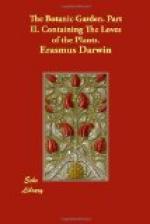[A plumed Lady leads. l. 226. The seeds of many plants of this class are furnished with a plume, by which admirable mechanism they are disseminated by the winds far from their parent stem, and look like a shuttlecock, as they fly. Other seeds are disseminated by animals; of these some attach themselves to their hair or feathers by a gluten, as misleto; others by hooks, as cleavers, burdock, hounds-tongue; and others are swallowed whole for the sake of the fruit, and voided uninjured, as the hawthorn, juniper, and some grasses. Other seeds again disperse themselves by means of an elastic seed-vessel, as Oats, Geranium, and Impatiens; and the seeds of aquatic plants, and of those which grow on the banks of rivers, are carried many miles by the currents, into which they fall. See Impatiens. Zostera. Cassia. Carlina.]
Queen
of the marsh, imperial DROSERA treads
Rush-fringed
banks, and moss-embroider’d beds;
Redundant
folds of glossy silk surround
Her
slender waist, and trail upon the ground;
235 Five sister-nymphs collect with graceful
ease,
Or
spread the floating purple to the breeze;
And
five fair youths with duteous love comply
With
each soft mandate of her moving eye.
As
with sweet grace her snowy neck she bows,
240 A zone of diamonds trembles round her brows;
Bright
shines the silver halo, as she turns;
And,
as she steps, the living lustre burns.
[Drosera. l. 231. Sun-dew. Five males, five females. The leaves of this marsh-plant are purple, and have a fringe very unlike other vegetable productions. And, which is curious, at the point of every thread of this erect fringe stands a pellucid drop of mucilage, resembling a ducal coronet. This mucus is a secretion from certain glands, and like the viscous material round the flower-stalks of Silene (catchfly) prevents small insects from infesting the leaves. As the ear-wax in animals seems to be in part designed to prevent fleas and other insects from getting into their ears. See Silene. Mr. Wheatly, an eminent surgeon in Cateaton-street, London, observed these leaves to bend upwards, when an insect settled on them, like the leaves of the muscipula veneris, and pointing all their globules of mucus to the centre, that they compleatly intangled and destroyed it. M. Broussonet, in the Mem. de l’Acad. des Sciences for the year 1784. p. 615. after hiving described the motion of the Dionaea, adds, that a similar appearance has been observed in the leaves of two species of Drosera.]
Fair
LONICERA prints the dewy lawn,
And
decks with brighter blush the vermil dawn;
245 Winds round the shadowy rocks, and pansied vales,
And
scents with sweeter breath the summer-gales;




